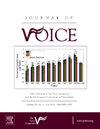Behavioral Treatment Approaches to Lowering Pitch in the Female Voice
IF 2.4
4区 医学
Q1 AUDIOLOGY & SPEECH-LANGUAGE PATHOLOGY
引用次数: 0
Abstract
Purpose
To assess the outcomes of three voice therapy treatment approaches with an emphasis on lowering speaking pitch. Transmasculine and cisgender individuals may desire to lower their speaking pitch, yet there has not been a method described in the literature to do this effectively using only behavioral techniques.
Method
To investigate these approaches, we enrolled 32 adult cisgender females and randomly assigned them to one of four treatment groups: vocal function exercises (VFE), resonant voice therapy (RVT), lip-rounding therapy (LRT), and a control group. Participants received individual instruction and feedback on the given exercise program, and they continued to practice daily for 4 weeks.
Results
Acoustic recordings were collected before treatment, immediately after the first session, and after 4 weeks of treatment. Results showed a lower minimum pitch in the physiological range, lower speaking fundamental frequency (SFF) in reading, and lower SFF in spontaneous speech—with treatment groups performing better than the control group. Additionally, participants’ self-rating of the vocal effort expended to speak in a low pitch decreased over the treatment period.
Conclusions
Each treatment approach (VFE, RVT, and LRT) was successful in lowering the speaking pitch of cisgender females. These methods would likely be useful for clients seeking to speak in a lower pitch. Future research may expand results to include clinical populations, such as transmasculine individuals.
降低女声音调的行为治疗方法
目的: 评估三种嗓音治疗方法的效果,重点是降低说话音调。跨性别者和顺性别者可能希望降低说话音调,但文献中还没有描述仅使用行为技术就能有效降低音调的方法:为了研究这些方法,我们招募了 32 名成年顺性别女性,并将她们随机分配到四个治疗组中的一个:发声功能练习组(VFE)、共鸣嗓音治疗组(RVT)、圆唇治疗组(LRT)和对照组。受试者接受个人指导和反馈,并持续每天练习 4 周:结果:在治疗前、第一次治疗后和治疗 4 周后都收集了声音记录。结果显示,生理范围内的最低音调降低了,阅读时的说话基频(SFF)降低了,自发说话时的说话基频(SFF)降低了--治疗组的表现优于对照组。此外,在治疗期间,参与者对低音调说话所花费的发声努力的自我评价也有所下降:每种治疗方法(VFE、RVT 和 LRT)都能成功降低顺性别女性的说话音调。这些方法可能会对想要降低说话音调的客户有所帮助。未来的研究可能会将结果扩展到临床人群,如跨性别人群。
本文章由计算机程序翻译,如有差异,请以英文原文为准。
求助全文
约1分钟内获得全文
求助全文
来源期刊

Journal of Voice
医学-耳鼻喉科学
CiteScore
4.00
自引率
13.60%
发文量
395
审稿时长
59 days
期刊介绍:
The Journal of Voice is widely regarded as the world''s premiere journal for voice medicine and research. This peer-reviewed publication is listed in Index Medicus and is indexed by the Institute for Scientific Information. The journal contains articles written by experts throughout the world on all topics in voice sciences, voice medicine and surgery, and speech-language pathologists'' management of voice-related problems. The journal includes clinical articles, clinical research, and laboratory research. Members of the Foundation receive the journal as a benefit of membership.
 求助内容:
求助内容: 应助结果提醒方式:
应助结果提醒方式:


